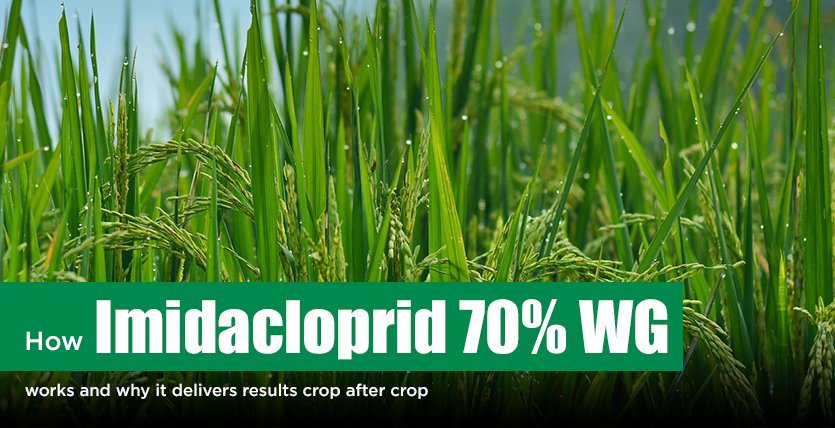There’s a reason why some products become irreplaceable in the world of crop protection. They don’t just work, but they work consistently, effectively, and across conditions. Imidacloprid 70% WG from Peptech Biosciences is one such solution. It is a successful product because of how it interacts with plants, how pests react to it, and that is why growers trust it. In this blog, let’s understand how this formulation works, which pests it targets, and how it becomes the product that can be included in pest management programs.
How does Imidacloprid 70% WG work? What is the science behind it?
Imagine a grower walking through a freshly sown cotton or paddy field. The seedlings are healthy, but there’s a silent threat that is lurking there, and those are tiny sap-sucking insects. These insects may be Jassids, Aphids, Whiteflies, or Brown plant hoppers. These pests may not be visible at first glance, but they’re already at work, piercing the tender tissues and draining nutrients.
The grower prepares a spray of Imidacloprid 70% WG, a water-dispersible granule that mixes effortlessly without foaming or clogging. Once applied, the formulation spreads uniformly over the leaf surface. But that’s just the beginning.
Thanks to its systemic properties, Imidacloprid doesn’t stay on the surface. It penetrates the plant cuticle and enters the vascular system through xylem. It then moves upward with the plant’s water flow. As a result, it protects not only the sprayed portion, but also newly forming leaves and shoots that grow in the following days.
Now, when pests land on these protected plants and begin feeding, they ingest minute yet lethal doses of the active ingredient. The molecule binds to nicotinic acetylcholine receptors (nAChRs) in the insect’s central nervous system. This binding is so strong and irreversible that it causes immediate disruption of nerve signals. Feeding stops within minutes. Disorientation sets in. Paralysis follows. Death occurs within a matter of hours.
All of this happens without any visible residue, without affecting the plant’s physiology, and without harming most beneficial insects. This makes Imidacloprid 70% WG a silent but strategic guardian of crop health.
Who is it Targeting? And on which crops?
Imidacloprid 70% WG can be effective in multiple crops:
| Crop | Key Pests Controlled |
| Cotton | Jassids, Aphids, Whiteflies |
| Paddy | Brown Planthopper, Green Leafhopper |
| Sugarcane | Early shoot borer, Root borer (indirectly via control of vectors) |
| Vegetables | Thrips, Aphids, Whiteflies, Leafhoppers |
| Mango / Citrus | Hoppers, Psylla, Mealybugs |
Whether the sucking insects are in early stages or they are virus-transmitting vectors, this formulation delivers preventive and curative action.
What makes Imidacloprid 70% so effective?
The real strength of Imidacloprid 70% WG lies in its highly targeted mode of action at the neural level of insect pests. The nAChRs we mentioned earlier, are vital for transmitting nerve impulses. They are the “switches” that keep the insect’s nervous system functioning and when Imidacloprid attaches to these receptors, they get overstimulated. The pest experiences a flood of continuous nerve signals, leading to convulsions, feeding inhibition, paralysis, and eventually death.
Its unique action profile brings several key advantages in the field:
- Fast acting protection
When insects ingest the ingredients, the insect’s feeding activity stops within minutes.. This prevents further plant damage almost immediately. This action becomes important during early crop stages because early pest attack can impact final yields.
- Long lasting residual control
Imida 70, once inside, provides residual protection for up to 10-14 days depending on crop and conditions.
- Selective and safe
At recommended doses, it doesn’t harm most pollinators and natural predators, hence it becomes selective in nature and due to this it becomes ideal for use in integrated pest management (IPM) programs, where preserving beneficial insects is as important as controlling pests.
- Lower resistance risk
Yes, Imida 70 from Peptech Biosciences, when used responsibly and rotated with other chemistries doesn’t let insects build resistance.
Recommended dosage and Method of application
Imidacloprid 70% WG needs to be applied at the right dosage and at the right time for best results.
Foliar spray recommendations:
- Dosage: 20-25 grams per acre
- Dilution: Mix in 150–200 litres of water per acre
- Spray Stage: Apply during early vegetative stage or when pests start appearing
| Crop | Suggested Spray Stage |
| Cotton | 20–30 DAS (days after sowing) |
| Paddy | Tillering stage or early signs |
| Okra | Vegetative stage |
| Chilli | Early flowering |
| Citrus | Post-pruning or early flush |
Conclusion: A tool that’s as strategic as it is scientific
Imidacloprid 70% WG is not just a product but it is a pest management strategy in itself. By combining systemic action, targeted control, and ease of application, it gives both growers and Agri-brands a tool that builds trust, loyalty, and results. In the broader fight against crop loss, its role is clear, it delivers clean leaves, protected sap flow, and pest-free vegetative growth – silently and effectively.
Frequently Asked Questions (FAQs)

